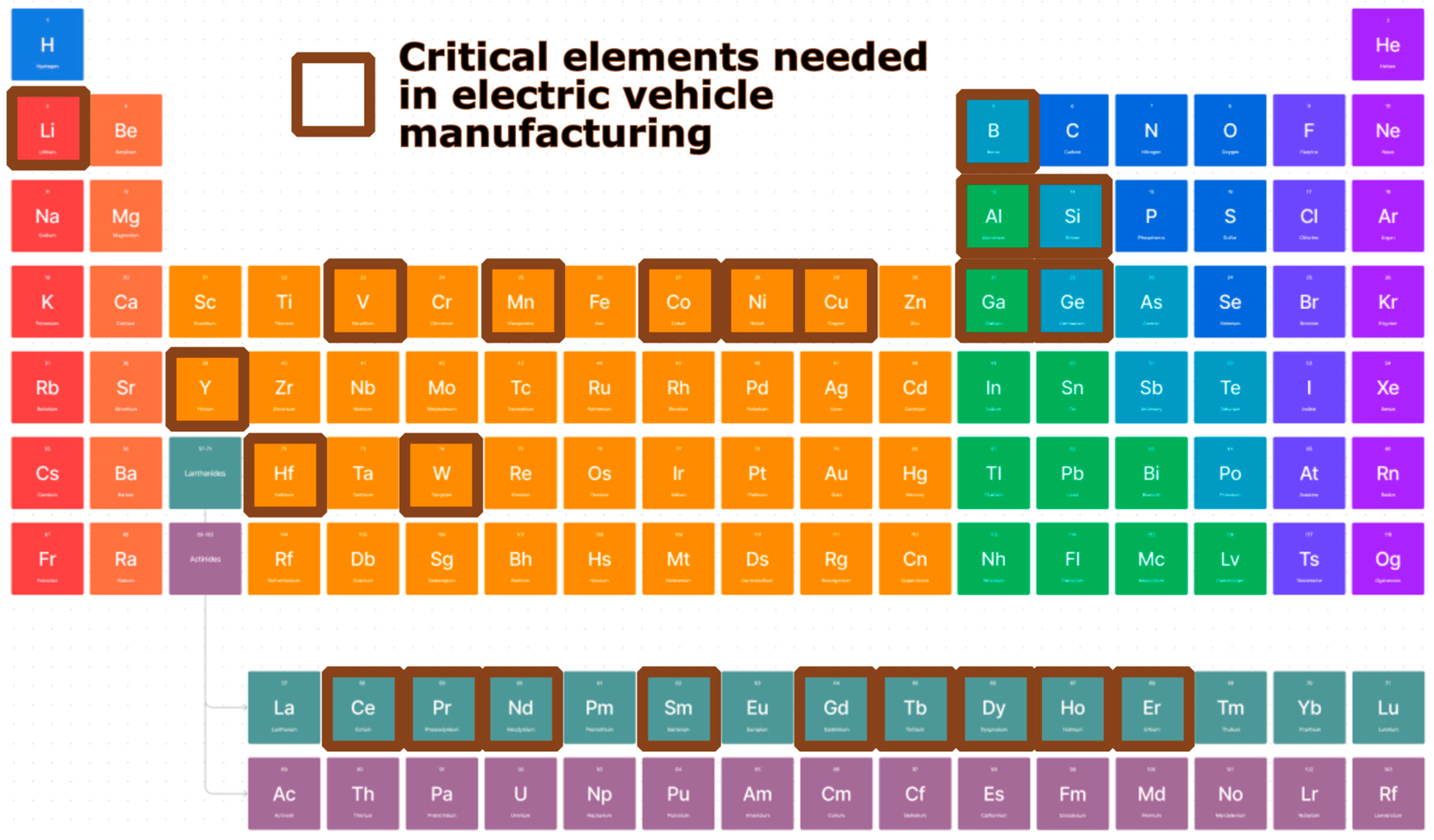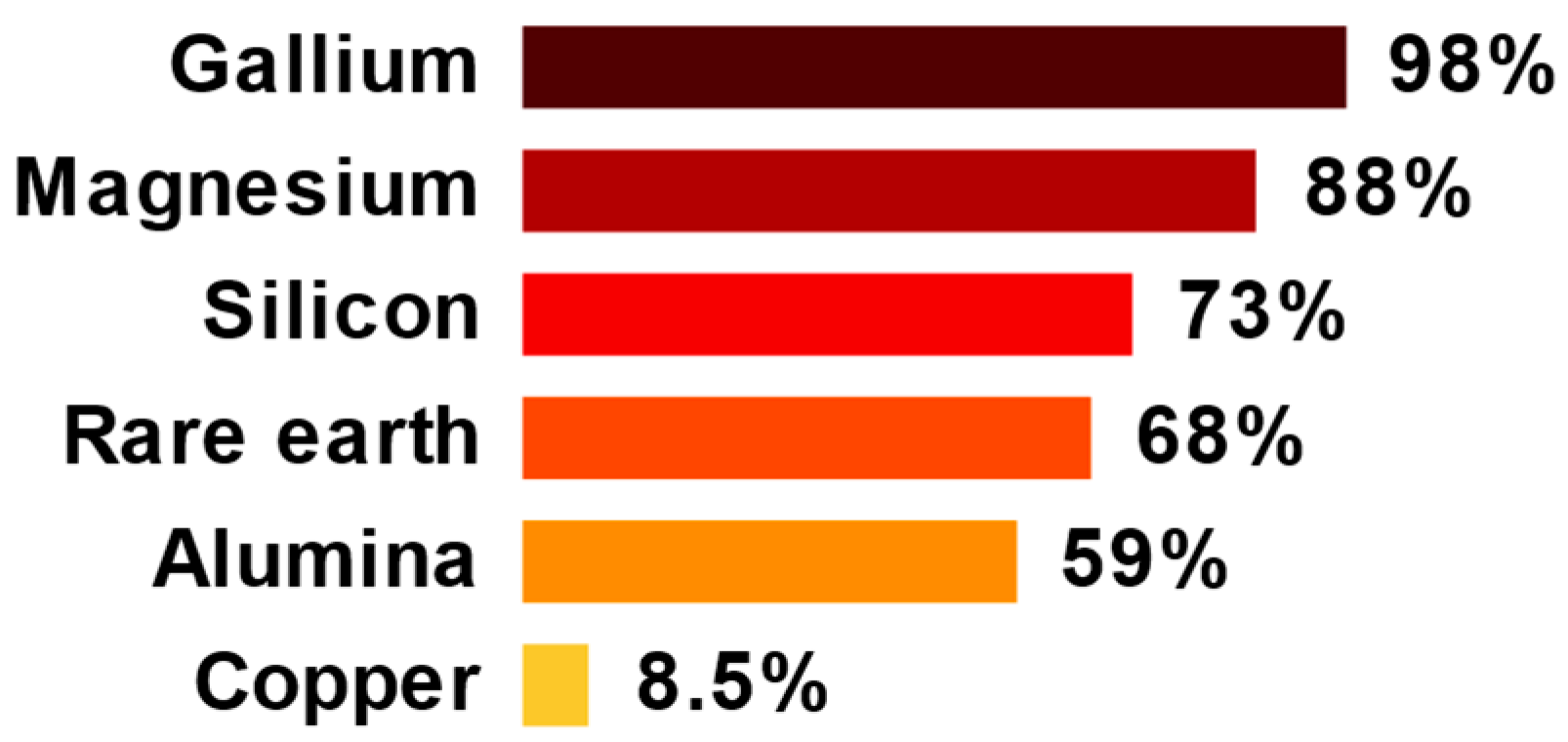Navigating Supply Chain Shortages in the Transition to Sustainable Transportation: The Role of Critical Materials Beyond Batteries †
Abstract
1. Introduction
2. Importance of Critical Materials in Sustainable Transportation
3. Supply Chain Shortages
4. Solutions and Mitigation Strategies
4.1. Legislative Actions
4.2. Technological Solutions
5. Conclusions
Author Contributions
Funding
Institutional Review Board Statement
Informed Consent Statement
Data Availability Statement
Conflicts of Interest
References
- Vandycke, N.; Viegas, J.M. Sustainable Mobility in a Fast-changing World: From Concept to Action; Palgrave Macmillan: London, UK, 2022. [Google Scholar]
- Pedersen, C.S. The UN sustainable development goals (SDGs) are a great gift to business! Procedia CIRP 2018, 69, 21–24. [Google Scholar] [CrossRef]
- Vescan, I.; Szabó, L. A Brief History of Electric Vehicles. J. Comput. Sci. Control Syst. 2022, 15, 19–26. [Google Scholar]
- Midttun, A.; Witoszek, N. Energy and Transport in Green Transition: Perspectives on Ecomodernity; Routledge: Abingdon, UK, 2016. [Google Scholar]
- Bobba, S.; Carrara, S.; Huisman, J.; Mathieux, F.; Pavel, C. Critical Raw Materials for Strategic Technologies and Sectors in the EU. A Foresight Study; European Union: Brussels, Belgium, 2020. [Google Scholar]
- Shaw, J. Supply Chain Considerations for GaN & SiC. Available online: https://epsnews.com/2024/07/02/supply-chain-considerations-for-gan-sic/ (accessed on 22 September 2024).
- Yan, W.; Wang, Z.; Cao, H.; Zhang, Y.; Sun, Z. Criticality assessment of metal resources in China. iScience 2021, 24, 102524. [Google Scholar] [CrossRef] [PubMed]
- LePan, N. How Much Copper Is in an Electric Vehicle? Available online: https://www.visualcapitalist.com/how-much-copper-is-in-an-electric-vehicle/ (accessed on 8 September 2024).
- Evans, G. 2024 EV Forecast: The Supply Chain, Charging Network, and Battery Materials Market. Available online: https://www.spglobal.com/mobility/en/research-analysis/2024-ev-forecast-the-supply-chain-charging-network-and-battery.html (accessed on 11 September 2024).
- 2022 Final List of Critical Minerals; U.S. Geological Survey: Washington, DC, USA, 2022.
- Proposal for a Regulation of the European Parliament and of the Council Establishing a Framework for Ensuring a Secure and Sustainable Supply of Critical Raw Materials; European Comission: Brussels, Belgium, 2023.
- Jula, P.A.; Mákszem, B.; Gaidamac, T.; Popa, D.C.; Szabó, L. Tackling risks in the supply chain of rare earth-based permanent magnets used in electrical generators. In Proceedings of the 2023 International Conference on Clean Electrical Power (ICCEP), Terrasini, Italy, 27–29 June 2023; pp. 852–857. [Google Scholar] [CrossRef]
- Nakano, J. The Geopolitics of Critical Minerals Supply Chains; Center for Strategic and International Studies: Washington, DC, USA, 2021. [Google Scholar]
- Popa, D.C.; Szabó, L. Overcoming catch-22 for rare earth metals in green transition: Solutions in electrical machine manufacturing. Renew. Sustain. Energy Rev. 2025, 207, 114917. [Google Scholar] [CrossRef]
- Statista. Available online: https://www.statista.com (accessed on 11 August 2024).
- Geopolitics of the Energy Transition—Critical Materials; International Renewable Energy Agency (IRENA): Masdar City, United Arab Emirates, 2023.
- The Supply of Critical Raw Materials Endangered by Russia’s War on Ukraine. Available online: https://www.oecd.org/en/publications/the-supply-of-critical-raw-materials-endangered-by-russia-s-war-on-ukraine_e01ac7be-en.html (accessed on 29 August 2024).
- Kalantzakos, S. Critical Minerals, the Climate Crisis and the Tech Imperium; Springer Nature: Cham, Switzerland, 2023. [Google Scholar]
- Artudean, D.; Aitonean, N.; Pârcălab, M.; Popa, D.C.; Szabó, L. Strategic Resource Challenges in the Development of Smart Cities. In Proceedings of the 2024 IEEE International Conference on Automation, Quality and Testing, Robotics (AQTR), Cluj-Napoca, Romania, 16–18 May 2024. [Google Scholar] [CrossRef]
- Küblböck, K. The EU Raw Materials Initiative: Scope and Critical Assessment; Austrian Foundation for Development Research (ÖFSE): Vienna, Austria, 2013. [Google Scholar]
- Carminati, R. Critical raw materials act, ambitious goals. Electr. Mot. Eng. 2023, 3, 20–22. [Google Scholar]
- Inflation Reduction Act; US Senate: Washington, DC, USA, 2022.
- Sidorenko, O.; Sairinen, R.; Moore, K. Rethinking the concept of small-scale mining for technologically advanced raw materials production. Resour. Policy 2020, 68, 101712. [Google Scholar] [CrossRef]
- Brandão, M.; Lazarevic, D.; Finnveden, G. Handbook of the Circular Economy; Edward Elgar Publishing: Cheltenham, UK, 2020. [Google Scholar]
- Szabó, L.; Szabó, G.S.; Szabó, R. Usage of Graphene in Power Systems. A Survey. In Proceedings of the 2020 XI International Conference on Electrical Power Drive Systems (ICEPDS), St. Petersburg, Russia, 4–7 October 2020. [Google Scholar] [CrossRef]
- Szabó, L. Additive Manufacturing of Cooling Systems Used in Power Electronics. A Brief Survey. In Proceedings of the 2022 29th International Workshop on Electric Drives: Advances in Power Electronics for Electric Drives (IWED), Moscow, Russia, 26–29 January 2022. [Google Scholar]
- Cheng, Y.; Wang, T.; Zhang, G. Artificial Intelligence for Materials Science; Springer: Cham, Switzerland, 2021. [Google Scholar] [CrossRef]
- Marti, K. Stochastic Optimization Methods; Springer: Berlin/Heidelberg, Germany, 2005; Volume 2. [Google Scholar]
- Szabó, L.; Fodor, D. The key role of 3D printing technologies in the further development of electrical machines. Machines 2022, 10, 330. [Google Scholar] [CrossRef]
- Szabó, L. Advancements in Electrical Machines Design Brought by the Modular Construction. In Proceedings of the 2018 X International Conference on Electrical Power Drive Systems (ICEPDS), Novocherkassk, Russia, 3–6 October 2018. [Google Scholar] [CrossRef]


Disclaimer/Publisher’s Note: The statements, opinions and data contained in all publications are solely those of the individual author(s) and contributor(s) and not of MDPI and/or the editor(s). MDPI and/or the editor(s) disclaim responsibility for any injury to people or property resulting from any ideas, methods, instructions or products referred to in the content. |
© 2024 by the authors. Licensee MDPI, Basel, Switzerland. This article is an open access article distributed under the terms and conditions of the Creative Commons Attribution (CC BY) license (https://creativecommons.org/licenses/by/4.0/).
Share and Cite
Artudean, D.; Kertész, N.; Popa, D.-C.; Bacali, L.; Szabó, L. Navigating Supply Chain Shortages in the Transition to Sustainable Transportation: The Role of Critical Materials Beyond Batteries. Eng. Proc. 2024, 79, 13. https://doi.org/10.3390/engproc2024079013
Artudean D, Kertész N, Popa D-C, Bacali L, Szabó L. Navigating Supply Chain Shortages in the Transition to Sustainable Transportation: The Role of Critical Materials Beyond Batteries. Engineering Proceedings. 2024; 79(1):13. https://doi.org/10.3390/engproc2024079013
Chicago/Turabian StyleArtudean, Diana, Norbert Kertész, Dan-Cristian Popa, Laura Bacali, and Loránd Szabó. 2024. "Navigating Supply Chain Shortages in the Transition to Sustainable Transportation: The Role of Critical Materials Beyond Batteries" Engineering Proceedings 79, no. 1: 13. https://doi.org/10.3390/engproc2024079013
APA StyleArtudean, D., Kertész, N., Popa, D.-C., Bacali, L., & Szabó, L. (2024). Navigating Supply Chain Shortages in the Transition to Sustainable Transportation: The Role of Critical Materials Beyond Batteries. Engineering Proceedings, 79(1), 13. https://doi.org/10.3390/engproc2024079013







